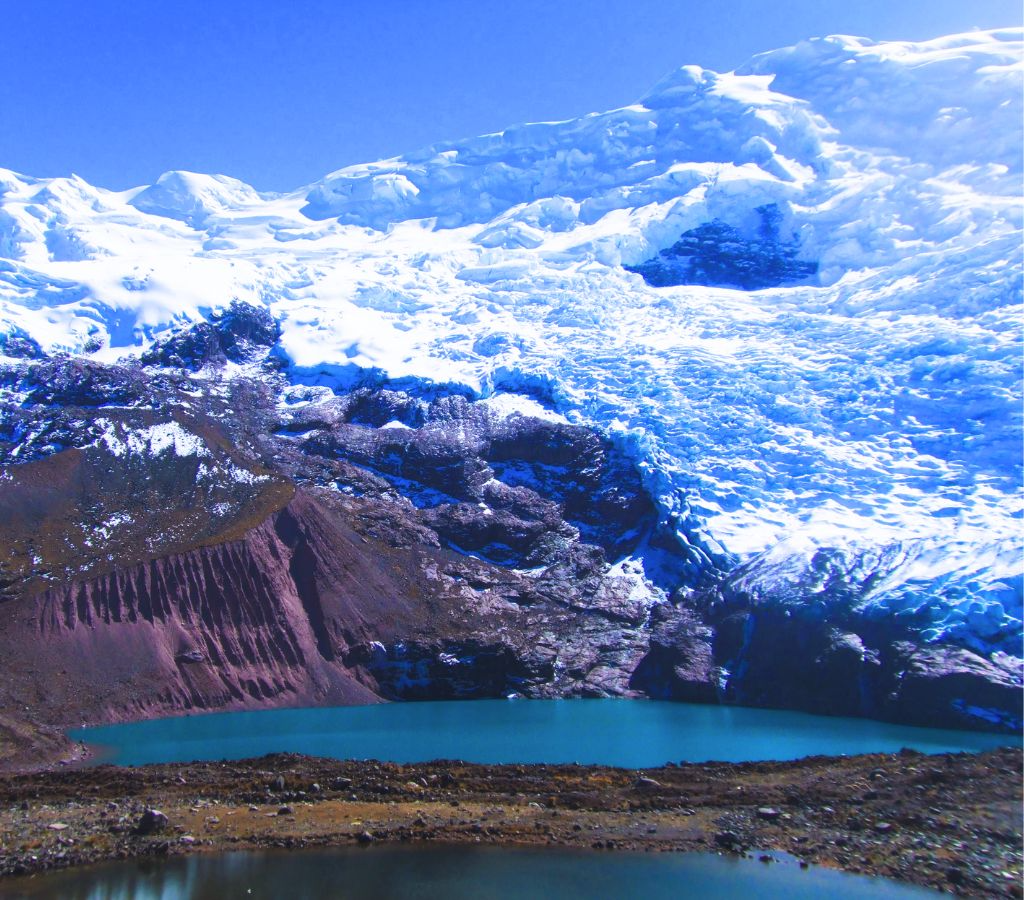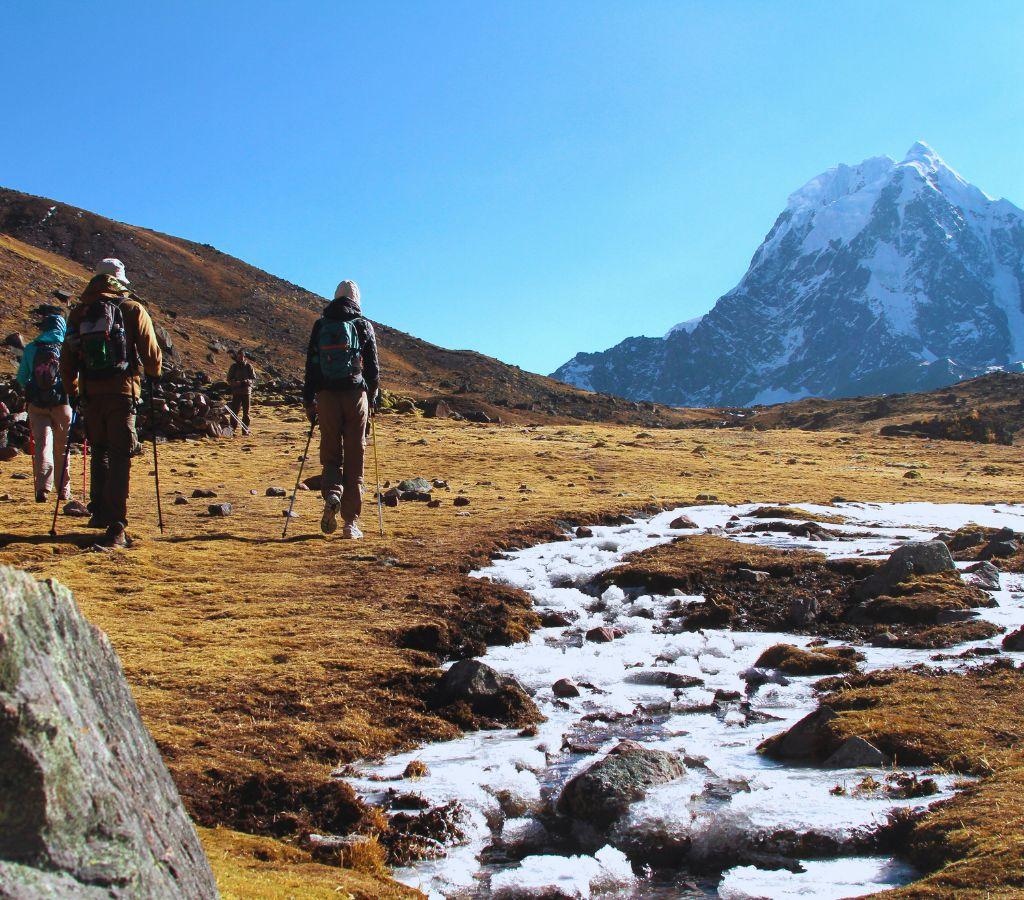The Ausangate Snowcapped Mountain, a natural gem of Cusco, captivates with its spectacular landscapes, where the majesty of its natural formations causes astonishment. Here, not only will you find dazzling lagoons like Sibinicocha, with its turquoise waters, but also stone forests, glaciers, and high plateaus that turn this place into a true earthly paradise.
Every corner reveals the magnificence of nature, offering a sublime experience to those who venture to explore its trails. Thus, it is not merely a geographical prominence but also a symbol deeply rooted in the rich local culture, where it is considered a divine guardian and revered by the locals as a protective deity or Apu.
Ausangate Snowcapped Mountain is an imposing snow-covered peak located in the Vilcanota mountain range, southeast of Cusco. It is considered a sacred mountain, a protective deity, and a source of water, making it a site of great spiritual and cultural importance for local communities.

Ausangate Snowcapped Mountain is located in the Cusco region, specifically in the district of Ocongate, province of Quispicanchi, approximately 110 km from the city of Cusco.
The main access routes to Ausangate are as follows:
An alternative route is to reach the district of Checacupe and head to Combapata, Cancha Cancha, and the town of Pitumarca, the starting point of the several-day Ausangate Trek around the mountain.
The coordinates of Ausangate Snowcapped Mountain are approximately: South latitude: 13° 37' 24" and West longitude: 71° 23' 07". Below is a map showing the exact location of this majestic mountain in the Peruvian Andes.
The climate at Ausangate Snowcapped Mountain varies according to the season and altitude. During the day, temperatures can range between 5°C and 15°C, but they can drop considerably at night, especially in higher areas, reaching below freezing temperatures. It is important to be prepared for sudden weather changes.
From the city of Cusco, you can reach Ausangate Snowcapped Mountain by land transport. The most common route is to take a bus or hire a private transport service to the town of Tinqui, which serves as the starting point for excursions to Ausangate. From Tinqui, hikes or horseback rides can be organized to the base of the mountain.
Ausangate Snowcapped Mountain offers a variety of tourist activities for visitors who want to explore this impressive region. From trekking and hiking to adventure sports and outdoor activities, there are options for all tastes and skill levels.
One of the most popular activities at Ausangate Snowcapped Mountain is trekking and hiking. There are several highlighted routes that offer stunning views of snow-capped peaks, glacial lagoons, and spectacular landscapes. Some of the most popular routes include the Ausangate Circuit, which completely surrounds the mountain, and the hike to Laguna de Sibinacocha.

In addition to trekking, Nevado Ausangate is also a popular destination for lovers of adventure sports and outdoor activities. Activities such as rock climbing, mountaineering, mountain climbing, mountain biking and fishing in glacial lagoons are available. Visitors can also enjoy natural thermal baths in the area.
It is important that visitors to Nevado Ausangate practice responsible tourism that respects the environment and local communities. This includes following conservation rules, such as respecting the culture, picking up solid waste and respecting local traditions, we must be respectful of nature.
Ausangate Snowcapped Mountain is enveloped in a rich tradition of legends and myths that have been passed down from generation to generation by local communities. One of the most important festivities is the Qoyllur Riti, which is celebrated at the foot of Ausangate and represents gratitude for the fertility and protection provided by the mountain.
The Qoyllur Riti Festival is one of the largest and most important religious pilgrimages in the Cusco region and part of Latin America. This festival takes place every year between May and June at the sanctuary of the Lord of Qoyllur Rit'i, located at 4,500 meters above sea level on the slope of Ausangate Snowcapped Mountain.
Thousands of pilgrims from different regions of the country attend this festival to pay homage to Christ in his Andean manifestation. According to legend, an indigenous boy saw another boy named Mariano Mayta, and they became friends and herded together until the boy he had met became the image we know today, the Lord of Qoyllur Riti.
After this event, the young shepherd died and was buried at the base where the Lord is now located. Since then, the sacred rock with the image of Christ engraved on it has become an important pilgrimage center. During the festival, devotees climb in procession with candles and crosses to the Ausangate glacier to worship the Lord of Qoyllur Rit’i (snow star) in a celebration that merges Catholic traditions and pre-Hispanic Andean beliefs.
It is a unique manifestation of Andean popular religiosity and the strength of faith in the Andes, declared Intangible Cultural Heritage of Humanity. It is undoubtedly a mystical and invaluable cultural experience.
Ausangate Snowcapped Mountain is considered a protective deity in Andean cosmology. It is believed that Ausangate controls the weather and forces of nature and is responsible for maintaining balance in the world. According to local legends, Ausangate is inhabited by powerful spirits that protect those who respect and venerate the mountain.
Legend of the Ausangate and Salkantay Brothers: According to Inca tradition, Salkantay and Ausangate were two brothers who resided in Cusco. Amid a devastating drought in the region, both ventured to distant lands with the purpose of aiding the people in crisis. Salkantay headed north and encountered the lush jungle, where he fell in love with Veronica, a forbidden love.
On the other hand, Ausangate traveled south to the highlands, where he discovered an abundance of Andean foods, such as camelid meat, corn, and potatoes, which he sent back to the population. Today, the community of Chillca, mostly composed of farmers and llama and alpaca herders, is recognized as the protector of these wonderful lands.
Annually, at the foot of the mountain, the Qoyllur Ritti festival is celebrated, which means "snow of stars" in Quechua. During this event, the Corpus Christi festival is celebrated, during which thousands of people pilgrimage to the Sinakara temple, where a painting of the crucified Christ carved on a rock is located. This pilgrimage was declared Intangible Cultural Heritage of Humanity in 2004.
If you are planning to visit Ausangate Snowcapped Mountain, we will help you organize your trip and make it an unforgettable experience.
Within our tourism program, we have various packages designed to meet the needs and preferences of our visitors. Our tour packages include transportation, accommodation, specialized guides, and depending on the program, tourist activities to explore the natural and cultural beauty of Ausangate Snowcapped Mountain.
Contact us via WhatsApp at +51 944 714 563 or email us at info@illapa.com to book your tour and experience a new adventure in the Andes.
To ensure a safe and enjoyable experience at Ausangate Snowcapped Mountain, it is important to follow some useful tips provided by the guide.
Visiting the impressive Ausangate Snowcapped Mountain in Cusco is quite an adventure, but it requires proper planning, and what better way to do it than with Illapa Andean Cultures, a tourism agency certified and verified by the Peruvian State.
These are the things you have to bring:
The best time to visit Ausangate Snowcapped Mountain is during the dry season, which runs from May to September. During these months, the climate tends to be more stable, and conditions are optimal for outdoor activities and enjoying the stunning views of the mountainous landscape.
However, keep in mind that temperatures can be cold, especially at night, so make sure to be well-prepared for the weather.
I hope this comprehensive information about Ausangate is useful to you. We are here to plan your dream trip to the heart of the Peruvian Andes whenever you desire.


